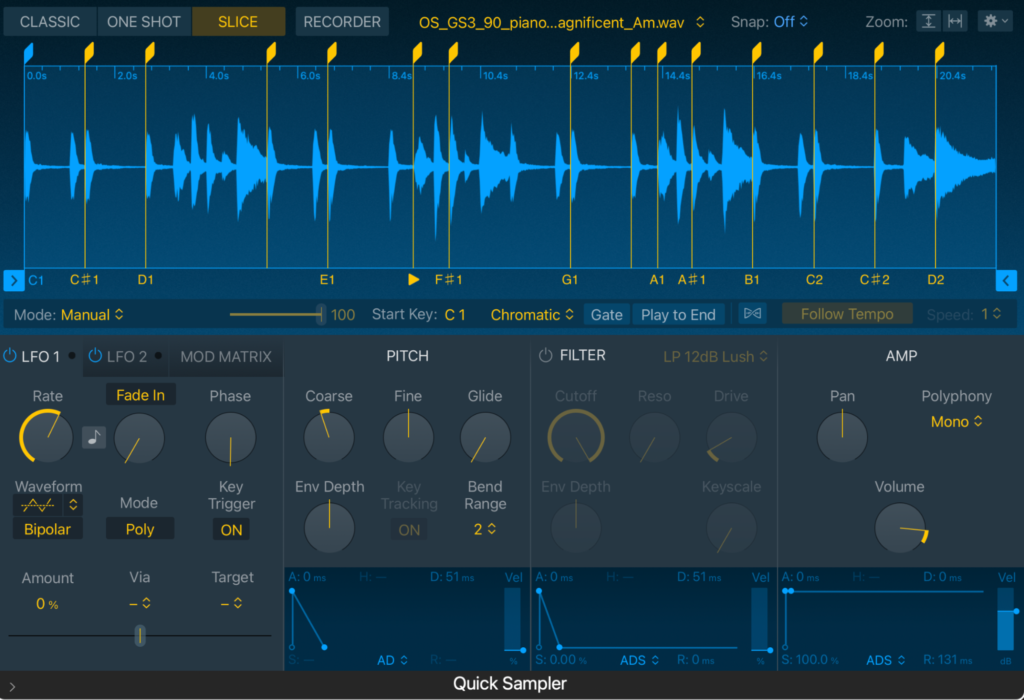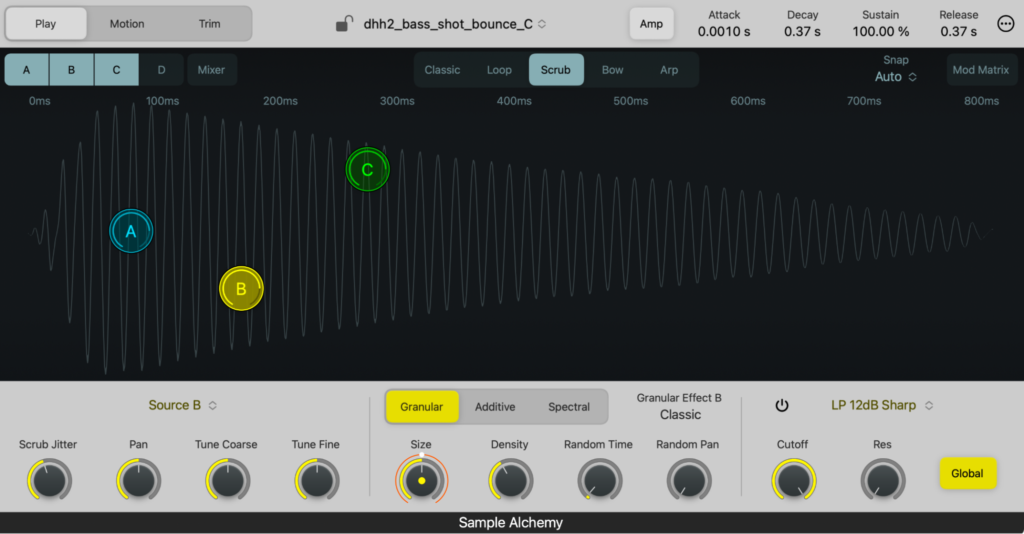Logic Pro is a treasure trove for music producers, and its three samplers—Quick Sampler, Sampler, and Sample Alchemy—are standout tools that can redefine how you manipulate audio.
Each sampler has its unique strengths, from slicing up loops to crafting detailed instruments and even transforming audio into complex synthesized textures. In this in-depth Logic Pro sampler guide, we dive into the details of each plugin and explore how you can use them to take your productions to the next level—follow along via the tutorial video above to hear them in action, and read highlights below.
1. Quick Sampler

A streamlined, one-sample powerhouse, Quick Sampler is your MPC-inspired slicing machine. It’s designed to be fast and intuitive, letting you drag in a single sample and immediately start chopping, tweaking, and playing. Think of it as your go-to option for quick creative ideas and laying down beats.
Key features of Quick Sampler
Drag-and-drop from everywhere: Import a sample directly from your Splice Sounds library, desktop, or even Logic’s timeline. For the latter, you can just drag an audio region straight into the plugin, or select a section using the marquee tool—anything goes.
Slice mode: Automatically divide your sample into slices based on transients, beat divisions, or manually-set markers. You can then move the starting point of each slice as you please, and add or remove slices with a single or double click.
Pitch adjustment: Tune individual slices by semitone or cents for harmonic or rhythmic variation, and to match the tonality with other elements in your production.
Filter section: Apply low-pass and high-pass filters to shape your sound. This is especially useful for removing unwanted frequencies or adding character. You can of course use an EQ for this, but I prefer the hands-on experience of doing it within the plugin.
Glide function: Seamlessly transition between slices for a smooth, legato effect. This is perfect for monophonic synth sounds, for example, but it’s also fun to try it out on different sources. Slices of a piano loop can be made to sound slightly off-pitch, creating a more rugged vibe.
Amp envelope: Control the attack, decay, sustain, and release to eliminate clicks or create dynamic movement.
Mono/poly mode: Choose whether slices can overlap (polyphonic) or only play one at a time (monophonic). I personally like to keep it in mono 99% of the time.
When to use Quick Sampler
Melodic sampling: Make a melody by slicing up a part of a song or a Splice sample. You can record as you experiment with different settings and sequences, and stop when you find something nice. Here’s a hot tip: For a sample that features a full arrangement, use the Stem Splitter in Logic Pro to isolate the instrument you want (this is perfect for remixing).
Drum breaks: Drag in a drum loop or percussion sample, slice it up, and rearrange it to create entirely new grooves. I usually slice drums at 1/4 or 1/8 per bar, depending on the complexity of the drum break. In the tutorial above, I used 1/4.
2. Sampler

The successor to Logic’s legendary ESX24, Sampler is your modular powerhouse for multi-sampled instruments. It’s built for multi-sampling, where you can map multiple audio files across a keyboard, tweak every detail, and turn raw audio into a playable instrument.
Key features of Sampler
Dual filter section: Shape your sound with two filters that can work independently or blend together. Options include low-pass, high-pass, and comb filters, with the ability to add drive for extra warmth or grit.
Modulation matrix: Add dynamic movement by assigning modulation sources (LFOs and envelopes) to targets like pitch, filter cutoff, or volume.
Flexible modulators: Add or subtract LFOs and envelopes as you please, which you can then use to manipulate different sections of a sound.
Keyboard mapping: Assign specific samples to ranges on your MIDI keyboard or controller. For example, load a piano sample pack and map each note to its respective key. Or, have your favorite kicks, snares, and hi-hats distributed across the piano roll. And lastly, you can of course just insert a single sound and spread it out so you can play it back with different pitches.
Key and velocity ranges: Define how samples respond to pitch and velocity for a more realistic and expressive instrument.
Flexible playback: Adjust sample start points, looping, and playback direction for granular control.
When to use Sampler
Building custom instruments: Use Sampler to turn field recordings, vocals, or instrument snippets into rich, playable patches.
Layering textures: Combine multiple samples with different modulation settings to create lush, evolving soundscapes.
Advanced beat programming: Map drum samples to individual keys for precise programming and dynamic drum kits.
Creative sound design: Use modulations to morph static samples into pulsating, evolving sounds, like we did with the brass sound in the video.
3. Sample Alchemy

Blurring the lines between sampling and synthesis, Sample Alchemy is a sound designer’s dream. Using the same engine as Logic’s flagship Alchemy synth, it allows you to deconstruct, manipulate, and reimagine samples in extraordinary ways.
Key features of Sample Alchemy
Granular, additive, and spectral synthesis modes: Transform your sample’s playback and texture with synthesis techniques that stretch, fragment, and morph sounds into something entirely new.
Various playback modes: Sample Alchemy features a host of playback modes for maximum expression.
- Classic: Plays the sample from start to finish.
- Loop: Loops the sample for pads or sustained effects.
- Scrub: Lets you “scratch” through a sample, offering incredible creative possibilities.
- Bow: Emulates bowed string instruments for organic textures.
- Arp: Allows for basic arpeggiation.
Layering options: Stack up to four different playback modes to create layered, complex sounds.
Advanced modulation: Shape the sound further with Alchemy’s robust modulation system, including envelopes and LFOs.
Time-stretch and pitch manipulation: Create lush pads, eerie drones, or otherworldly sound effects by stretching your sample to extreme lengths or radically altering its pitch.
When to use Sample Alchemy
Cinematic sound design: Use the rich sound design options to create atmospheric pads, risers, and transitions. Two of the pads I made in the video were achieved with Sample Alchemy.
Add fatness and texture to bass sounds: Load in a single bass note sample and play with the additive or spectral modes to create some sweet layers. This is excellent if you want your bass to cut through the mix (before going down the saturation route).
Logic Pro sampler guide: Conclusion
Logic Pro’s three samplers—Quick Sampler, Sampler, and Sample Alchemy—each bring something unique to the table. From the simplicity and speed of Quick Sampler to the in-depth control of Sampler and the boundary-pushing flexibility of Sample Alchemy, these tools virtually cover every sampling need imaginable.
That said, the use cases for each sampler described in this article are merely anecdotic. In practice, you may discover completely different applications for using these. In any case, I would love to hear which Logic Pro sampler you prefer and what you use it for—let me know your thoughts in the comments section of the video, and subscribe to the Splice YouTube channel for more tutorials.
Get free mixing templates
Last but not least, when your beat or song is done, you must mix it. If you’re looking to level up your mixing game, grab my six free mixing templates for Logic Pro here. If used effectively, they should save you time and help you get professional results faster.
Explore royalty-free sounds from leading artists, producers, and sound designers:
February 11, 2025




.svg)
.svg)
.svg)
